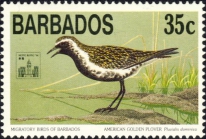
| Introduction | | Search taxa | | Taxon tree | | Taxon match | | Checklist | | Literature | | Stats | | Photogallery | | OBIS Vocab | | Log in |
CaRMS taxon detailsPluvialis dominica (Müller, 1776)
159136 (urn:lsid:marinespecies.org:taxname:159136)
accepted
Species
marine, terrestrial
Not documented
Description Length: 23-26 cm. Plumage: non-breeding adult greyish brown spotted golden above; conspicuous superciliary stripes golden...
Description Length: 23-26 cm. Plumage: non-breeding adult greyish brown spotted golden above; conspicuous superciliary stripes golden yellow and extend well behind eyes; underparts lightly mottled greyish or brownish yellow; belly and crissum white. Breeding adult black spotted golden with more white than non-breeding. Immature resembles non-breeding adult, but more yellow with brown spots on flanks. Bare parts: iris brown; bill black; feet and legs slate grey. Habitat: marine shores and estuaries. Vagrant in WIO. <389><391><393> [details] Distribution Caribbean, North America
Distribution Caribbean, North America [details]
CaRMS (2021). Pluvialis dominica (Müller, 1776). Accessed at: http://www.marinespecies.org/Carms/aphia.php?p=taxdetails&id=159136 on 2024-04-24
Nozères, C., Kennedy, M.K. (Eds.) (2024). Canadian Register of Marine Species. Pluvialis dominica (Müller, 1776). Accessed at: https://marinespecies.org/carms/aphia.php?p=taxdetails&id=159136 on 2024-04-24
Date action by
context source (HKRMS)
Morton, B. & Morton, J. (1983). <i>The sea shore ecology of Hong Kong</i>. Hong Kong: Hong Kong University Press. 350 pp. [details]
context source (RAS) Australian Antarctic Data Centre. , available online at https://data.aad.gov.au/aadc/biodiversity/ [details] context source (Bermuda) Amos, E. J. R. (1991). A Guide to The Birds of Bermuda. 206 pp [details] basis of record Banks, R.C., R.W. McDiarmid, and A.L. Gardner. 1987. Checklist of vertebrates of the United States, the U.S. Territories, and Canada. U.S. Fish and Wildlife Service Resource Publication No. 166. 79 p. [details] additional source Robbins, C. S. (1983). Golden field Guide to Birds of North America. Golden press. 360p. [details] additional source Linkletter, L. E. (1977). A checklist of marine fauna and flora of the Bay of Fundy. <em>Huntsman Marine Laboratory, St. Andrews, N.B.</em> 68: p. [details] additional source Peterson, R.T.; Peterson, V.M. (2002). A field guide to the birds of eastern and central North America. <em>Fifth Edition.</em> Peterson Field Guide Series. Houghton Mifflin Company. New York. 427 p. [details] additional source Squires, H. J. (1990). Decapod Crustacea of the Atlantic coast of Canada. <em>Canadian Bulletin of Fisheries and Aquatic Sciences.</em> 221: 532 p., available online at http://www.dfo-mpo.gc.ca/library/116743.pdf [details] additional source Vanner, M. (2003). The encyclopedia of North American birds. <em>Paragon Publishing.</em> 1-383. [details] additional source Urban, E. K.; Fry, C. H.; Keith, S. (1986). The Birds of Africa, Volume II. <em>Academic Press, London.</em> [details] additional source King, C.M.; Roberts, C.D.; Bell, B.D.; Fordyce, R.E.; Nicoll, R.S.; Worthy, T.H.; Paulin, C.D.; Hitchmough, R.A.; Keyes, I.W.; Baker, A.N.; Stewart, A.L.; Hiller, N.; McDowall, R.M.; Holdaway, R.N.; McPhee, R.P.; Schwarzhans, W.W.; Tennyson, A.J.D.; Rust, S.; Macadie, I. (2009). Phylum Chordata: lancelets, fishes, amphibians, reptiles, birds, mammals. <em>in: Gordon, D.P. (Ed.) (2009). New Zealand inventory of biodiversity: 1. Kingdom Animalia: Radiata, Lophotrochozoa, Deuterostomia.</em> pp. 431-554. [details] additional source Gallardo, J. C.; Macías, V.; Velarde, E. (2009). Birds (Vertebrata: Aves) of the Gulf of Mexico. <em>In: Felder, D.L. and D.K. Camp (eds.), Gulf of Mexico–Origins, Waters, and Biota. Biodiversity. Texas A&M Press, College Station, Texas.</em> Pp. 1321–1342. [details] additional source Integrated Taxonomic Information System (ITIS). , available online at http://www.itis.gov [details]  Present Present  Inaccurate Inaccurate  Introduced: alien Introduced: alien  Containing type locality Containing type locality
From other sources
Description Length: 23-26 cm. Plumage: non-breeding adult greyish brown spotted golden above; conspicuous superciliary stripes golden yellow and extend well behind eyes; underparts lightly mottled greyish or brownish yellow; belly and crissum white. Breeding adult black spotted golden with more white than non-breeding. Immature resembles non-breeding adult, but more yellow with brown spots on flanks. Bare parts: iris brown; bill black; feet and legs slate grey. Habitat: marine shores and estuaries. Vagrant in WIO. <389><391><393> [details]Dimensions Length: 10 1/2" (27 cm) [details] Distribution Caribbean, North America [details] Reproduction Breeds from Baffin Island in northern Canada to Alaska and eastern Siberia. Winters from Brazil to Argentina. In spring nearly all migrate west of Hudson Bay but in the fall a considerable part of the population move east to the Atlantic coast and fly from the Maritime Provinces or New England over the ocean to South America. [details]
|
